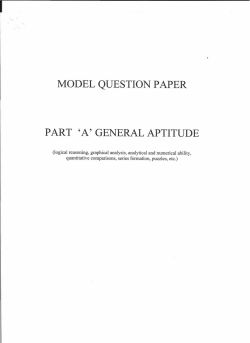
Start with a Circle... - Dick Blick Art Materials
Copyright © 2015 Dick Blick Art Materials All rights reserved 800-447-8192 DickBlick.com Start with a Circle... Geometric art kicks both the "left" and "right" sides of the brain into gear! (art + math) It's no secret that geometry and art are close friends. Since ancient times, artists have used shapes, portions of shapes, and repeating shapes to add interest to their art. Mathematical formulas based on the relationship of shapes to one another, such as the Golden Ratio and the Divine Proportion, have been used by artists, architects, and craftsmen for thousands of years in order to give their artwork dramatic impact. "Without mathematics there is no art,” said Luca Pacioli, a contemporary of Leonardo da Vinci. When a simple paper circle is divided into a semicircle (half), a quadrant (fourth), or smaller sectors (sixths, eighths) and those sectors are placed together on a plane (paper), geometric art is the result. As sectors of a circle overlap and interact with each other, the art becomes more complex, and so does the math. Overlapping colors form new colors. Intersecting lines form right, acute, and obtuse angles. Squares, triangles, and polygons are created within the design by aligning the straight portions of circle sectors. Using gridded paper to arrange pre-cut tissue paper circles is an easy way to align them and create symmetry. This lesson can be as simple as arranging circles and semi-circles for beginning mathematicians, while more advanced students use smaller sectors to create geometric patterns in their art. Materials (required) class size of 24 students. Adjust as needed. Bienfang Gridded Paper, 50-sheet pad, 11" x 17", 4 x 4 Grid (10613-1016); need one sheet per student Process - Elementary Roylco Tissue Circles, package of 480 assorted, 4"Dia (11301-1004); share at least one package across class GRADES K-8 Note: Instructions and materials are based upon a 1. Begin with a sheet of gridded paper. Determine the center by measuring or counting squares. 2. Using tissue paper circles and a glue stick, create a design using full circles, half-circles and/or quarter-circle segments from the defined point. Tissue circles can be cut by folding in halves or fourths and cutting on the fold lines. 3. As each tissue paper piece is put into place, outline it with a black fine point marker or a dark pencil. Shapes will overlap to define new shapes, and the outline will make them more visible and the overall artwork more cohesive. Process - Middle school and up 1. A mathematical formula known as the Golden Ratio has been adapted by artists since ancient times and most believe it to be the means to a perfect composition in art. Many know it as the "rule of thirds." Elmer's X-TREME School Glue Stick, .88 oz (23894-1025); need one per student Sharpie Fine Point Markers, black (21316-2001); need one per student Fiskars Student Scissors, 3" cut (57016-1065); need one per student Optional Materials Blick Aluminum Straightedge Rulers, 12" (56016-1012) 1. Process, continued Students can divide the gridded sheet into thirds and begin their composition from one of the intersecting points, or be challenged to combine their math and design skills to find the Golden Ratio. Phi - which is approximately 1.618 - is a the number that is believed to create the perfect proportion, the number that Leonardi da Vinci used extensively . 2. To find the Golden Ratio, measure the length of the sheet (in this case, 17 inches). The goal is to divide the length into two sections so that the longer section (a) divided by the smaller section (b) is also equal to 17 divided by the longer section (a). a formula 17 would look like this: Mathematically, the = b a b = a 17 a Step 1: Determine the starting point on a piece of gridded paper and build a design using full circles, semi-circles, and/or circle segments. 17” 17” To find (a) divide 17 x 1.618 (phi). With a little a 17 rounding up, it equals =10.5. Subtract (a) from 17 to b find (b) For this sheet, (a)a= 10-1/2" and (b) = 6-1/2". (a)a 17”17 b a (a) = (a) 17” 10.5” 10.5” (a) (b) (b) 11” 11” (b) 6.5” 11” (b)6.5”11” 10.5” 6.5” 10.5” 6.5” Repeat for the vertical measurement: c 11 = c d cc 1111 == c Vertically, it would d be (c) =c 6-3/4" and (d) = 4-1/4". d 17” Step 2: Outline each tissue paper piece with a fine line marker or pencil. 11out like the illustrations Visually, it could becdrawn = c 17” d below: 17” 17” 3. (c) 6.75” (c) 6.75” 11”11” (c) 6.75” (c) 6.75” 11” 11” (d) 4.25” (d) 4.25” (d) 4.25” (d) 4.25” 6.5” 10.5” 6.5” 10.5” 6.5” 10.5” 6.5” 10.5” Using tissue paper circles and a glue stick, create a design using full circles, semi-circles, and/or circle segments from the defined point. Tissue circles can be cut by folding in halves, fourths, sixths or eighths and cutting on the fold lines. 4. As each tissue paper piece is put into place, outline it with a black fine point marker or a dark pencil. Shapes will overlap to define new shapes, the outline will make them more visible, and the overall artwork more cohesive. Step 3: Seal the design when finished using clear adhesive film or lamination. 800-447-8192 DickBlick.com 2. Options: National Core Arts Standards - Visual Arts 1. Creating Once the sheet is filled, it can be sealed and protected with a piece of clear adhesive film or laminated. Anchor Standard 2: Organize and develop artistic ideas and work. Presenting Anchor Standard 4: Select, analyze, and interpret artistic work for presentation. Connecting Anchor Standard 10: Synthesize and relate knowledge and personal experiences to make art. 800-447-8192 DickBlick.com 3.
© Copyright 2025













